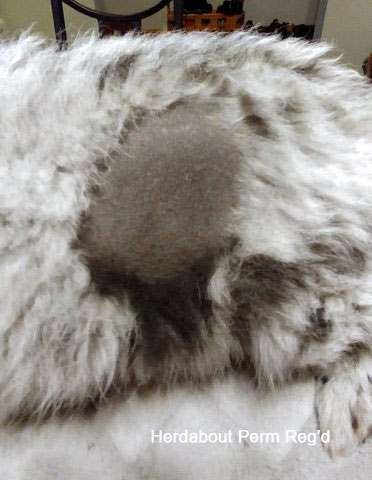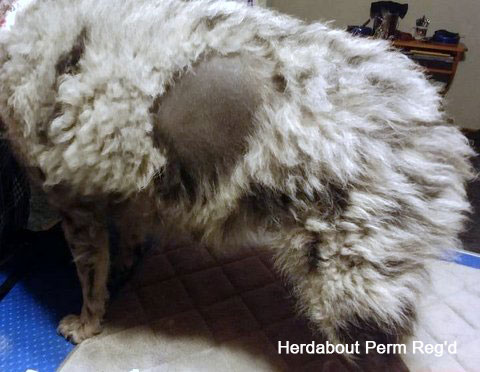At Herdabout Perm. Reg'd we strive to breed Mudis for health, temperament and structure. We are working to both preserve and improve the breed of Mudi for future generations. There is limited Real DNA testing for genetic disease available for Mudis, but we do complete all testing that is available to us. We are not persuaded by the anectdotal ideas of others who may have their own agenda on what to test for in the breed. We believe in real evidence, real science, and understand that DNA does not lie. We do not support any company, or laboratory, that offers "dirty lyse" or "marker based" testing. At Herdabout Perm. Reg'd we only use laboratories that do full DNA testing for Real Genetic Diseases.
We freely offer our Mudis DNA for testing to help scientists, veterinarians and laboratories find genes and help develop DNA tests that can help eliminate any genetic issues in the future. We live in exciting times and are honored to help better the science in order to breed better dogs.
GENETIC HEALTH TESTING
- Hips: We test all our adult breeding Mudis' Hips with PennHip to measure the degree of laxity in the hip joints. The OFA is subjective on how they grade Hips, but PennHip is an actual measurement that cannot be argued with. PennHip can certify hips prior to the dog being 2 years old. The science doesn't lie.
- Elbows: Currently the only governing body available to us that certifies elbows is the OFA. Actual certification can only be done at 24 months of age, however preliminary evaluation can be done as young at 12 months of age. With our many years of doing both Prelim and full Certification there has been no change in our dog's elbows between prelim exam and certification.
- Thyroid: OFA Thyroid full panel clearances. Results on ALL our breeding dogs have been Normal with TGAA Negative. This testing can be officially certified with OFA at 12 months of age.
- Eyes: ALL our breeding dogs have been tested and certified with CERF (Canine Eye Registry Foundation) for their eyes. Results on all our breeding dogs have been Normal, Clear of all genetic eye diseases with no genetic defect to prevent them from being bred.
- Dentition: All our breeding Mudis have had their dentition checked by a board certified veterinary dental specialist. Most of our breeding dogs are OFA certified with full dentition ( a few of our dogs have broken off some teeth biting on hard things, and don't qualify for full dentition certification).
- PLL (Primary Lense Luxation): This is a genetic eye disorder that can be tested for with DNA. It occurs primarily in Pulis, but since Pulis and Mudis are only seperated by coat type we test for it on all our breeding dogs. All our breeding dogs are DNA Clear for PPL.
- MDR1 Gene: Herding dogs such as Mudis, Shelties, Collies, Australian Shepherds, (and Long Haired Whippets) have a more porous lining to the sheath around their brain than other breeds of dogs. This causes drugs to saturate their brains immediately. The MDR1 Gene expresses a protein to flush the brain of the toxic effect caused by drugs. If the dog's MDR1 gene status is Normal/Normal then the dog could potentially take any drug dispensed by a veterinarian....but if the gene has a mutation (Normal/Mutant) then the dog will be limited, or even unable, to remove certain toxins from the brain.
Any dog who is MDR1 Normal/Mutant can suffer brain damage from certain drugs because of their toxic effect and the MDR1 gene not being able to do it's full job. A dog who is a MDR1 Mutant/Mutant status can even die from taking such drugs as the wormer Ivermectin. It is very important to know the MDR1 status of your dog in able to provide adequate medical care for your dog. All our breeding Mudis are DNA tested MDR1 Clear.
- DM (Degernative Myelopathy) is a crippling disease that affects the spinal cord in dogs, causing progressive muscle weakness and loss of coordination. It acts similarly to Lou Gehrig's disease, or ALS (amyotrophic lateral sclerosis), in humans. This issue is common in herding dogs and it DOES exist in Mudis. All our breeding Mudis are DNA tested DM Clear. We did have one Mudi that tested as a DM carrier but that Mudi was removed from our breeding program.
- VwD (Von Wille Brands) is a blood clotting disease. Dog can be Clear, Carrier or Affected. This is a disease primarily found in herding dogs, (VwD type III). Although other breeds of dogs can have their own sub-type of this disease. We consider testing for VwD type III a valid concern. While no Mudi has knowingly tested positive as Carrier or Affected, we do this test simply because the Mudi is a herding dog (just in case) as we have seen the devastating effect that VwD can have on other herding dogs.
- LCP (Legges Calves Perthes) is also known as avascular or aseptic necrosis of the femoral head. This is a condition in which the head of the femur ( the "ball" in the ball-and-socket hip joint) spontaneously begins to degenerate with bone reabsorbtion. The only cure is an invasive surgery to remove the femoral head, which leaves the femor (leg bone) unattached. All our breeding dogs are OFA Clear for LCP.
- Patellas (rear kneecaps) are a part of the stifle joint (knee). In patellar luxation, the kneecap luxates, (or pops out of place), either in a medial or lateral position. While Bilateral involvement is most common, unilateral movement can also happen. The most common symptoms is a knock-knee stance, or a dog that does a hop, skip, and shakes the kneecap back into place while running. Clinical findings show the medial retinacular tissues of the stifle joint are often thickened, and the foot can be seen to twist laterally as weight is placed on the limb. Surgery can be done to deepen the grove that the patella sits in and the kneecap stops popping out. Dogs can be OFA tested at 12 months and older. Patella Alta is a rare condition where the kneecap is actually too long and needs surgery to be trimmed down to normal size. All our breeding Mudis have been veterinary and/or OFA tested for Patellas.
- Epilepsy: The only way to diagnose Epilepsy is with an autopsy or by MRI. Whenever one of our Mudis die (whatever the cause) we have their body sent off for a full necropsy at the veterinary University of Guelph and have their brain checked for any evidence of Epilepsy. So far we have had two of our Mudis die (1 bit by rattlesnake, and 1 by tragedy) and sent off for full body necropsies. Both Mudis come back as CLEAR for Epilepsy. Any Mudi reaching the age of 5 years, with no seizures, is also a great indication that the dog dog does NOT have epilepsy, and we can declare them Epilepsy Free.
IN OUR DOG'S LINEAL RELATIVES THERE IS NO EPILEPSY
What is the truth regarding the situation on Epilepsy in the Mudi breed?
In the Mudi breed (as it is in people) there is a risk of 1 to 3%. What does this mean? It means that in a population (where there is no inbreeding) there is a small possibility that 1 Mudi in every 100 puppies born, may develop Epilepsy.
This is a very low risk and should not be looked at with fear or over thinking. Even though there are no Mudis with Epilepsy in our breeding dogs, a famous and popular stud dog with no history of Epilepsy in the bloodline may in 100 puppies (bred to many different females) produce 1 to 3 puppies with a Seizure disorder. That is still a very low risk, especially when considering that not all seizures are Epilepsy.
Seizures can be caused by many things: complications during labour at birth. Premature newborns with hypoxia which can lead to neurological problems and seizures. True Epilepsy can be acquired by an extremely high fever as is in the case of contracting Distemper, causing brain injury.
Any dog can have a seizure brought on by hypoglycemia, ataxia, reaction to medications (such as certain anesthetics), ingestion of toxic plants or poisons, severe pain, shock from a trauma, head or brain injury, tumours, vascular abnormalities, liver shunts, kidney problems, metobolic or digestive disorders, hemangiosarcomas and other cancers. These do not mean the dog has epilepsy, it only means the dog had a seizure reaction to an underlying condition.
Science has proved that the Isoxazoline class of drugs
(such as Bravetco, Nexgard, Nexgard Spectra, Simperica, Simperica Trio, and Credelio) CAN IN FACT cause seizures and brain damage in all breeds of dogs. In September 2018, the FDA put out a warning against this class of drugs, and in late 2022 the Quebec (Canada) government approved a class action lawsuit against Bravetco.
At Herdabout Perm. Reg'd our contract states that Isoxazoline drugs MUST NOT be given to our dogs.
- BHFD: Black Hair Folicle Dysplasia: Unfortunately we were on the cutting edge of making this scientific discovery. When one of our Mudis presented with baldness, only on the black skin and hair patches, we had discussions with some other Mudi breeders who had seen the same thing, but had no answers. We agreed to have our veterinarian take and send off biopsies of both the bald skin and furry skin to the scientists at the University of Guelph. It was then they discovered that the Mudi can have this disorder known as Black Hair Folicle Dysplasia. CHFD is also found in some other breeds of dogs. Currently there is no DNA testing to find a gene linked to this disorder, but at Herdabout Perm. Registered we no longer breed together the two dogs that created this affected Mudi.
BHFD does not affect the dog in any other way health wise, it is only a cosmetic condition with baldness on the black areas.



